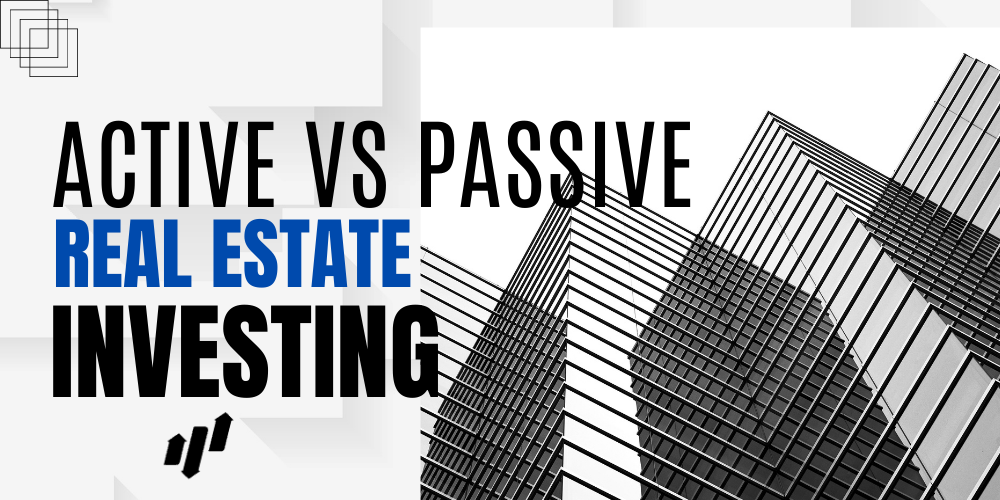Real estate investing can be a great way to make money and build wealth over time. However, there are two main types of real estate investment: active and passive.
So, which one is right for you? In this article, we will discuss active vs passive real estate investing so that you can decide which type is best for you!

What Is Active Real Estate Investing?
Active real estate investing is when you are directly involved in the property. You may be responsible for finding tenants, maintaining the property, and even making repairs. Active real estate investing can be a great way to make money, but it does require more work on your part.
The IRS offers some tax benefits for active real estate investments. But the more money you make, the fewer losses you can claim.
What Is Passive Real Estate Investing?
Passive real estate investing is when you invest in a property but are not directly involved in the day-to-day operations. You may hire a property manager to take care of the details for you.
Passive activities are any investments where you don’t have to materially participate in your investment activity. By default, real estate is considered a passive activity.
For a loss from passive investments to shelter other taxable income, the investor must have other real estate or assets generating tax-free earnings.
Otherwise, the investor will carry these losses forward until offset by an increase in earned profits from active activities that produce overnight cash flow.

Active vs Passive Real Estate Investing: Which Is Right for You?
The debate over whether to be an active or passive investor is often heated, but it doesn’t have to be. The primary benefit of each strategy depends on your goals and risk profile.
Now that you know the difference between active and passive real estate investing, it’s time to decide which one is right for you. If you’re looking to make some quick cash, active real estate investing may be the way to go. However, if you’re looking to build wealth over time, passive real estate investing may be the better option. Ultimately, the decision is up to you!
- Active investing is the opposite of passive. With active management, you can take a more hands-on approach by hiring someone like yourself for your portfolio needs and goals!
- There is no doubt that passive investments have garnered more investment flows than active ones. This is because passive investments can take advantage of market trends.
Passive Investing Advantages
The positives of investing passively in real estate are:
- You don’t have to spend your time managing the property and dealing with tenants, repairs, etc.
- Passive investing often requires less initial capital than active investing, making it a great option for those with limited funds.
- There are many tax benefits for passive real estate investors.
- Often less risky, but there are still risks.
Passive Investing Disadvantages
The key drawbacks of passive investments include:
- Active real estate investors have more control over their investments and can make quicker decisions.
- Passive investors may not be as intimately familiar with their investment properties as active investors are.
- Because passive investors don’t manage the day-to-day operations of their properties, they may have less bargaining power when it comes to tenant leases and other significant negotiations.
- Passive investing typically requires a longer time horizon than active investing, so investors must be patient to see results.
- There is always the potential for the property manager to make poor decisions that could negatively impact the value of the investment.
Active Investing Advantages
The key benefits of active investments include:
- Active investors have more control over their investments and can make quicker decisions.
- They are typically more familiar with their investment properties than passive investors are.
- They have more bargaining power when it comes to tenant leases and other significant negotiations.
Active Investing Disadvantages
The negatives of active real estate investing include:
- Active investors must be prepared to deal with the day-to-day management of their properties, including repairs, tenant issues, and more.
- This can be time-consuming and may not be suitable for those with full-time jobs or other commitments.
- Additionally, active real estate investments may be riskier than other investing strategies, making them a poor choice for risk-averse investors.
- Fewer tax benefits.
Conclusion
So, is active or passive real estate investing the right choice for you? The answer lies in your goals and what you are comfortable with. If you want to actively manage your properties and be hands-on in finding tenants and overseeing repairs, then active investing may be a good fit for you.
However, if you would rather have someone else take care of all of that for you, passive investing may be a better option. Either way, it’s important to do your research and understand the risks and rewards associated with each before making a decision.
Which type of real estate investor are you?


 Tags:
Tags:










